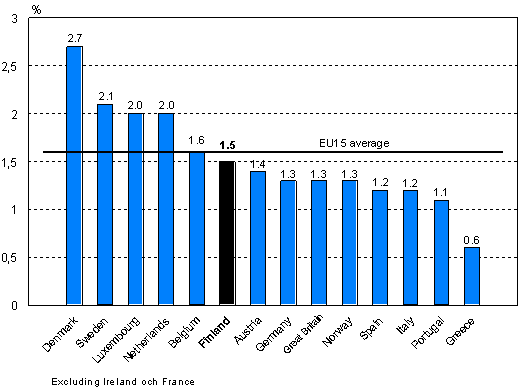Published: 26 November 2008
Purchasing of training services from private training enterprises has increased
Private training enterprises are the main party from which enterprises procure continuous vocational training services. Their share as organisers of course format training was nearly 50 per cent, which contained an increase of approximately 15 per cent from 1999. The share of educational institutions within the school system (vocational schools, polytechnics and universities) as well as publicly funded training institutions as providers of vocational training has diminished correspondingly. The share of these training institutions of the supplied training hours has fallen from 36 per cent to approximately 20 per cent.
Costs of personnel training are falling
In 2005, the amount enterprises invested in personnel training was EUR 522 per employee. In 1999, the respective figure was clearly higher, EUR 760. The decline in training activity is also seen in the relative share of training costs of labour costs. In 1999, training costs accounted for 2.4 per cent of labour costs whereas in 2005 the respective proportion was 1.5 per cent.
However, the general trend has also been declining in other European countries. Whereas in 1999 the average for the old Member States (EU15) was 2.0 per cent of labour costs, in 2005 it was 1.6 per cent. The relative decreases were the largest in Norway, Finland and the Netherlands.
Share of training costs of labour costs in EU15 Countries and Norway in 2005

Share of coaching for working life has grown
The emphasis in the training offered by enterprises to their personnel has shifted somewhat from the development of professional skills to the improvement of the general skills needed in working life and work communities. However, the input into the development of general working life skills has not increased quantitatively since 1999, but a slight change has taken place in the prioritisation of the contents of training instead. The share of language training has remained unchanged, but those of training relating to computer use and information technology and especially of training associated with office work, book-keeping, management and administration have diminished between 1999 and 2005.
The trends in the contents of training are also pan-European. Whereas in 1999, training related to computer use covered over 15 per cent of employees in most Member States, a share of over 15 per cent was only achieved in a couple of countries in 2005. The share of language training of training hours has remained unchanged and is higher than the average especially in the new Eastern European Member States.
Emphasis is shifting to internally organised training
In 1999, the share of training internally organised by enterprises themselves of all training courses was 47 per cent while that of training provided by external organisers was 53 per cent. By 2005, the proportions had become precisely reversed. In 2005, 53 per cent of all course training days were implemented as training organised by enterprises themselves.
Manufacturing industries resort to external training suppliers less often than service industries. Respectively, small enterprises use external services more than large enterprises as they have less of the required training resources themselves.
Young employees receive little training
During 2005, over 40 per cent of employees aged between 25 and 54 had participated in training courses. The respective figure for the age group of over 54 was 34 per cent and only 25 per cent among those aged under 25. Thus, young employees of enterprises do not receive or seek training in the same way as middle-aged or ageing employees.
No change from the previous situation has taken place in the participation rates of different age groups in Finland but in, for instance, Sweden, Denmark and Norway the differences in the participation rates of different groups were smaller than in Finland.
Young employees’ participation rate was slightly higher in manufacturing industries than in service industries. However, there were fairly large differences by industry within both sectors.
This is not necessarily a question of conscious policy among enterprises or of subconscious age discrimination. Underlying the phenomenon could be natural reasons relating to resources, training needs, or personnel’s competence and educational background.
Obstacles to training
Nearly one enterprise in four did not organise any personnel training in 2005. Approximately 60 per cent of these enterprises gave as the main reason for not organising training the fact that their personnel’s existing competence and qualifications met their present needs.
Other quoted reasons for not organising training included personnel’s time pressure and lack of time, which 40 per cent of enterprises gave as the reason, and the fact that the enterprise had recruited persons with the necessary competence and qualifications, which 37 per cent of enterprises gave as the reason.
The same three obstacles were also the most important ones in EU Member States, but with different shares.
Source: CVTS, Continuing vocational training survey, Statistics Finland
Inquiries: Hannu Virtanen 09–1734 2514, Tarja Seppänen 09–1734 3220
Director in charge: Riitta Harala
Updated 26.11.2008
Official Statistics of Finland (OSF):
CVTS, Continuing vocational training [e-publication].
ISSN=1798-0003. Participation in course-format training 2005. Helsinki: Statistics Finland [referred: 8.1.2026].
Access method: http://stat.fi/til/cvts/2005/02/cvts_2005_02_2008-11-26_tie_001_en.html

